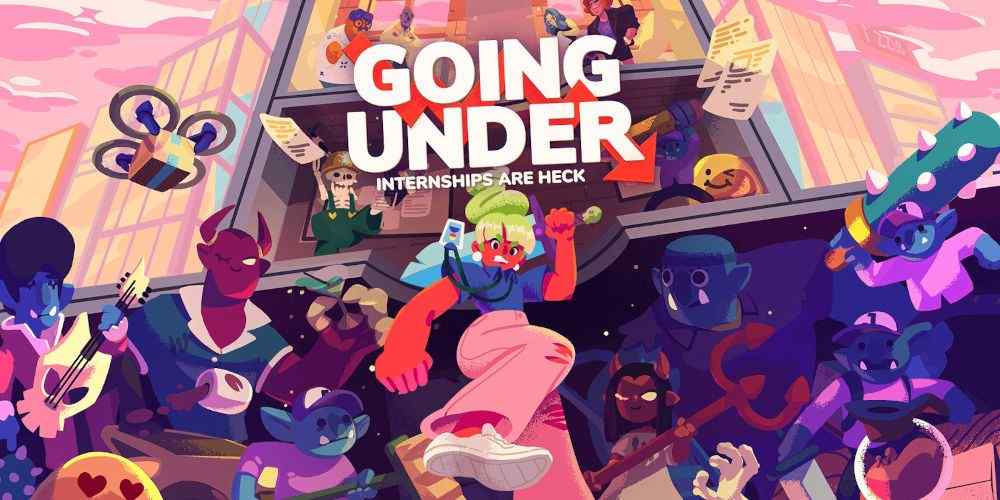I heard of Going Under about a week before it launched on September 24, 2020—and the premise hooked me right away. A procedurally-generated third-person dungeon crawler that satirizes the world of tech startups?
On paper, that checks off nearly everything I'm looking for in a game these days, and the fact that it was available for the Nintendo Switch sealed the deal. I had to check it out.
But to my disappointment, Going Under proved itself to be yet another warning about indie video games: what sounds good on paper and what you actually get in the end product can be worlds apart. To say that it fell short of expectations... would be right on target.
Disclaimer: My copy of Going Under was provided by Aggro Crab Games, but my opinions in this review are my own and haven't been influenced in any way.
The Good
Going Under is on par with most indie action-adventure games: you explore dungeons (in this case, the "dungeons" are basement levels of a tech startup's office building), you swing your weapon at foes, and you try to reach the end before you die.
So what sets it apart? For starters, every room is littered with environmental objects that you can pick up and use as your weapon. Between the occasional swords and spears you might find, there are also desk chairs, keyboards, monitors, potted plants, and more. Some objects inflict more damage, but they might slow you down or take longer to swing; other objects might swing faster or have a wider range per attack, but don't dish out as much pain. You can also throw objects at enemies, and dodge their attacks with well-timed evasive maneuvers.
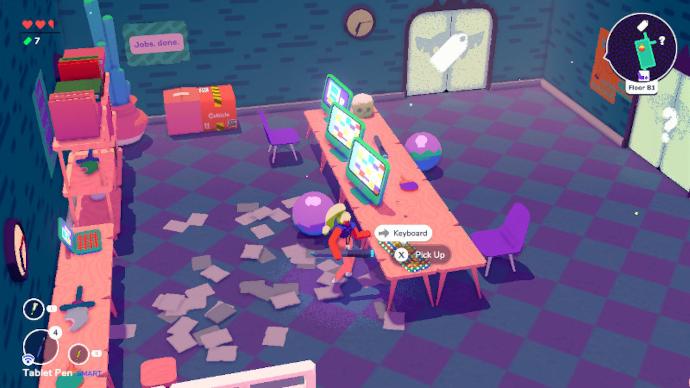
And every object-weapon breaks after some number of hits, so you're always picking up whatever you can find in the environment. Fortunately, to mitigate some of the luck factor, you can hold up to three object-weapons at a time and switch between them at the press of a button. Juggling the different pros and cons of object-weapons is part of the skill in Going Under, which should appeal if you like optimizing limited options.
Between dungeon runs, the Fizzle headquarters building acts as a central hub where you can chat with your co-workers, pick up side tasks, and track your progress. Your character grows with every dungeon run, so with every attempt you'll be able to get just a bit further than last time—assuming you're productive on each run, which isn't always the case due to the procedurally generated nature of every dungeon level.
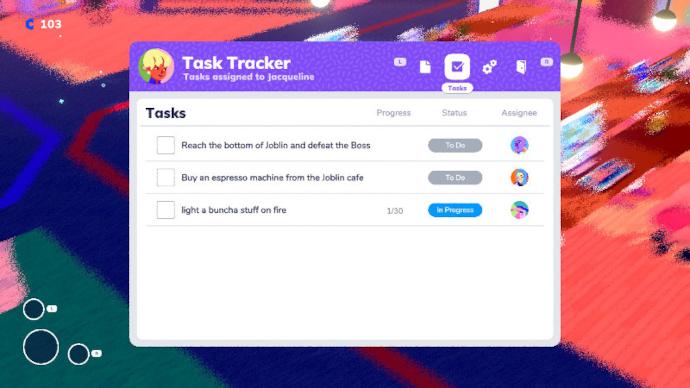
Gameplay aside, the main draw of Going Under is its absurd, wacky, and lighthearted humor that saturates the entire game. You're an intern at Fizzle, and your character development is framed accordingly: you pick a "mentor" to change your character style, you have LinkedIn-style "skill endorsements" for growth, and you have an app-style "Tasks List" instead of a quest tracker. Not to mention that all of your co-workers are various tech startup stereotypes, complete with buzzword lingo and nerdy quirks.
And the silliness of the game comes through even in its music, which I'd describe as abstract elevator music. It's calming and easy to listen to, fading into the background as you bounce from room to room, whacking away at enemies and scouring each dungeon level.
The Bad
The first thing I noticed is that the graphics in Going Under are terribly fuzzy. For reference, I played on a TV via docked Nintendo Switch, but even in handheld mode the artifacts were pretty evident. It almost seems like an intentional art choice, given that transparent effects are similarly fuzzy—and if the look is by design, it wasn't executed well. To me, Going Under is repulsively ugly with too much contrasting colors that distract more than anything.
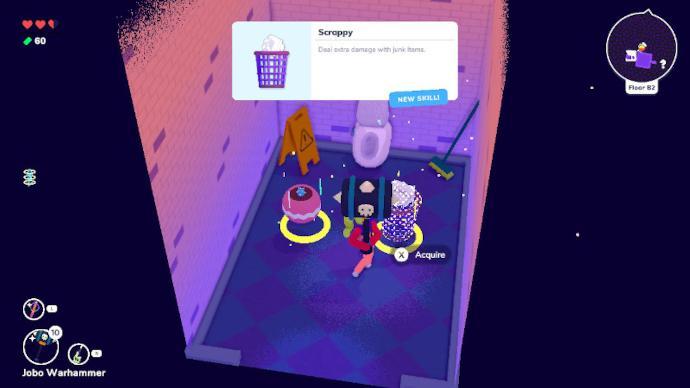
Gameplay-wise, there are some cool ideas but they don't come together to provide an intriguing experience. For example, the environmental object-weapons concept is awesome, but there isn't enough variety between options. Once you've run a dungeon a few times, it becomes clear that some objects are better than others, and you end up ignoring most of the environment on subsequent runs.
The combat is also disappointing. I like action-oriented dungeon crawling, but the overall system design in Going Under is too shallow for anything deeper than mindless button mashing. Yeah, you can dodge, yeah, you can throw stuff, but they feel more like novelties than practical tactical choices. You're way too vulnerable with most actions—perhaps a symptom of a poorly balanced system—and the most effective path becomes slash, slash, slash to victory.
And despite the procedurally-generated nature of the game, Going Under feels way too samey from run to run. There's a severe lack of variety between rooms, with boring and uncreative color palettes and world design, with too much reuse of the same rooms, leading every run to feel like deja vu even if the layout is completely different.
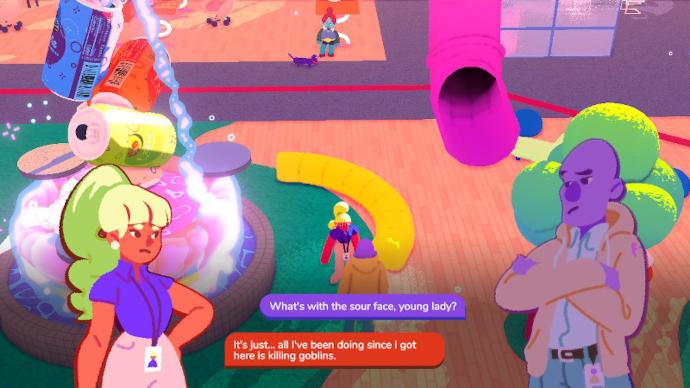
For an action-oriented game, there's WAY too much non-action. It felt like I sat through an hour of "funny" dialog before I even got to do anything, and most of that dialog was meaningless. Too many jokes, too many side characters, too much poorly-executed-yet-unnecessary character development for a paper-thin story.
And the humor fell incredibly flat for me. It's the kind of quirky humor that's played out in indie games, the kind that I've been over since 2016. As a result, I found the dialog to be boring at best and cringey more often than not. But maybe you'd enjoy it. Humor is subjective, after all.
The Verdict
Overall, Going Under shows a lot of promise but is missing critical refinements in gameplay and aesthetics that would've been needed to push it up from "This game is OK" to "Wow, this game rocks!"
As it stands, the game is fun and I don't find myself bored when I'm playing it—but when I'm not playing it, I never think about it and I don't really want to play it. The $20 price tag is a bit much; I recommend waiting until you can grab it on sale for $10, or even $5.
Going Under is the first game by Aggro Crab Games, a five-man indie game development team based out of Seattle, WA and led by Caelan Pollock and Nick Kaman.
Going Under
Going UnderThe Good
- Absurd, wacky, and lighthearted humor
- Action-packed, skill-based combat mechanics
- Procedural generation for replayability
- Fun and silly background music
The Bad
- Fuzzy and unappealing graphics
- Frustrating combat mechanic quirks
- Too much unnecessary dialog for a thin story premise
- Jokes are derivative and played out
